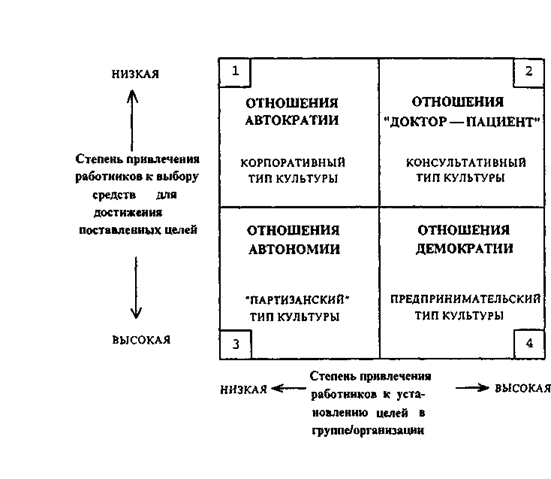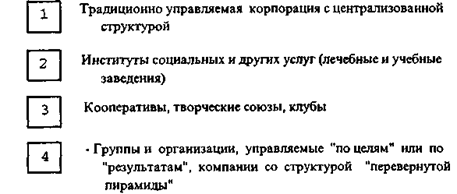home
 Management Management
 Management - Vikhanskiy OS Management - Vikhanskiy OS
|
Management - Vikhanskiy OS
2. Development of organizational culture
2.1. Formation of organizational culture
As shown in previous chapters, the external environment has a significant impact on the organization, which, naturally, affects its culture. However, as practice shows, two organizations operating in the same environment can have very different cultures. This is because, through their joint experience, the members of the organization differently solve two very important problems. The first is an external adaptation: what should be done by the organization and how it should be done. The second is internal integration: how the employees of the organization solve their daily problems related to their work and life in the organization (Table 10.1).
Table 10.1.
Problems of external and internal integration (according to E. Shayn)
PROBLEMS OF EXTERNAL ADAPTATION AND SURVIVAL |
|
• MISSION AND STRATEGY. Determination of the mission of the organization and its main tasks; The choice of strategy to fulfill this mission • OBJECTIVES. Setting specific goals; Agreement on goals • FACILITIES. Methods used to achieve goals; Agreement on the methods used; Decisions on the organizational structure, incentive systems and subordination • CONTROL. Establishment of criteria for measuring the results achieved by the individual and groups of results; Creation of an information system • CORRECTION. The types of actions required for individuals and groups that did not complete assignments |
PROBLEMS OF INTERNAL INTEGRATION |
|
• GENERAL LANGUAGE AND CONCEPTUAL CATEGORIES • Choice of methods of communication; Determine the meaning of the language and concepts used • BORDERS OF GROUPS AND CRITERIA FOR ENTRY AND EXIT FROM GROUPS. Establishing criteria for membership in the organization and its groups • POWER AND STATUS. Establishment of rules for the acquisition, maintenance and loss of power; Definition and distribution of statuses in the organization • PERSONAL RELATIONS. Establishment of rules on the level and nature of social relations in the organization between the sexes, ages, etc .; Determining the permissible level of openness at work • AWARDS AND PUNISHMENTS. Determination of desirable and undesirable behavior • IDEOLOGY AND RELIGION. Determination of the meaning of things that can not be explained and are not subject to control by the organization; Faith as a stress reliever |
The process of external adaptation and survival is associated with the search and finding of an organization's niche in the market and its adaptation to the constantly changing external environment. This is the process of achieving the organization's goals and interaction with representatives of the external environment. In this process, issues related to the tasks performed, methods for solving them, reactions to successes and failures, etc. are being addressed.
Using the developed joint experience, the members of the organization develop common approaches that help them in their activities. People need to know the real mission of their organization, and not what is so beautifully claimed from high tribunes for shareholders. This will help them form an understanding of their contribution to the organization's fulfillment of their mission.
The next group of questions relates to setting goals and selecting means to achieve them. In some organizations, employees participate in setting goals and, thus, take responsibility for achieving them. In others, workers participate only in the choice of methods and means to achieve goals, and in the third, there can be neither one nor the other, or both (Figure 10.4).
In any organization, its employees tend to participate in the following processes:
• to allocate from the external environment an important and unimportant for the organization;
• Develop ways and means of measuring the results achieved;
• find an explanation for success and failure in achieving goals. It is noted that workers need to develop acceptable
Ways of bringing to the representatives of the external environment information about their real capabilities, advantages and successes. Some companies organize trips for their purposes to their employees and customers 'enterprises, and to suppliers' enterprises.
It is also important that the organization is aware of when it is possible to admit failure. To this end, individual companies in the development of new projects set boundaries, on which, due to failure, the project is curtailed. This is officially provided for in the project document, so everyone is aware of this.
The process of internal integration is connected with the establishment and maintenance of effective relations of work between members of the organization. This is the process of finding ways to work together and coexist in the organization. The process of internal integration often begins with the establishment of specificity in the definition of oneself, which refers both to individual groups (subcultures) and to the entire collective of the organization. Often this leads to differentiation of the organization. Thus, the after-sales service division of the Russian corporation ASI received its "new definition of itself", becoming an independent company.

TYPICAL EXAMPLES:

Fig. 10.4. Types of cultures as power relations in a group / organization
(According to R. Ackoff)
Communicating and interacting, the members of the group / organization tend to describe the organizational world surrounding them. They can come to the conclusion that it is changing or stagnant, full of opportunities or dangers. So, people will go to innovations if they believe that they can make important changes in the world around them and what used to be a danger can now become an opportunity for change.
The formation of an organizational culture, its content and its individual parameters is influenced by a number of factors of the external and internal environment.
At all stages of the organization's development, the managerial culture of its leader (his personal faith, values and style) can largely determine the culture of the organization (Table 10.2). To a very large extent, the influence of the leader or founder of the company on the formation of culture is manifested if he is a strong (clearly expressed managerial culture) person, and the organization is only being created.
Formation of the culture of the organization is connected with the environment that is external to the organization:
• business environment in general and in the industry in particular;
• samples of national culture.
The company's acceptance of a certain culture may be related to the specific nature of the industry in which it operates, with the speed of technological and other changes, with the peculiarities of the market, consumers, and so on. It is known that companies in the branches of "high technology" have a culture that contains "innovative" values and faith in "changes". However, this feature can be manifested in different ways in companies of the same industry, depending on the national culture within which a company operates.
Analysis of the factors of the formation of organizational culture shows that the latter is the subject of development and change throughout the life of the organization. At the same time, due to the "depth" of the basic assumptions and their "stability," these processes proceed more gradually and evolutionarily than radically and revolutionaryly.
TABLE 10.2.
Two approaches to the formation of organizational culture by leaders
Administrative |
Organizational Variables |
Entrepreneurial Culture |
From the outside |
Control system |
From the inside |
Proprietor of the process |
Property Relationships |
Property Owner |
Waiting for the moment |
Attitude to opportunities |
Conducts a search |
Rationally logical |
Primary problem solving |
Intuitive |
Centralization |
Delegation of authority |
Decentralization |
Hierarchical |
Organizational structure |
Network |
"Adult" - "child" |
Subordination relations |
"Adult" - "adult" |
Organization |
Organizational focus |
Per person |
Decrease in cost |
Production strategy |
Differentiation Of production |
Performance |
Main Objectives |
Efficiency |
System |
Approach to management |
Situational |
Integration |
The work is designed from the standpoint of |
Autonomy |
Continuation of Table. 10.2
According to the rules |
Completing of the work |
Creative |
Modification |
Changes |
Radical |
Doing the right thing |
Fundamental course Of action |
Do the right thing |


Comments
When commenting on, remember that the content and tone of your message can hurt the feelings of real people, show respect and tolerance to your interlocutors even if you do not share their opinion, your behavior in the conditions of freedom of expression and anonymity provided by the Internet, changes Not only virtual, but also the real world. All comments are hidden from the index, spam is controlled.